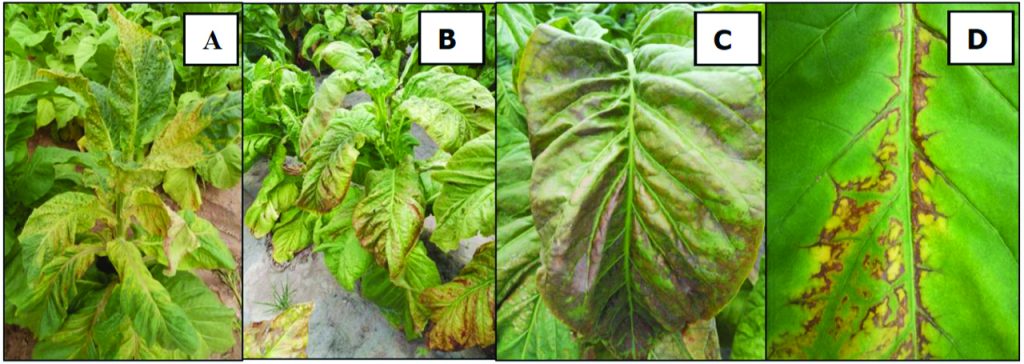Article by: The Tobacco Research Board, (TRB)
There have been several reports of PVY in tobacco field crops around the tobacco growing areas. The occurrence of PVY has been observed sooner than expected in normal seasons. This explosion of reports has come through the Plant Clinic and observations have also been made during visits to farms in all tobacco growing areas. PVY is a viral disease (Fig. 1) primarily transmitted by the tobacco aphid Myzus persicae nicotianae. It is not seed-borne.
Symptoms of both the necrotic and mosaic strains (Fig 1), which can cause significant yield losses, have been observed. Tobacco cultivars in Zimbabwe do not yet have resistance to PVY although efforts are currently under way to breed for resistance. Although PVY is mainly transmitted by aphids, recent work indicates that it can also be mechanically transmitted by workers, farm implements and leaf-to-leaf contact. As such, farmers are encouraged to rigorously control insect pests, especially aphids, in their crops. Additionally, growers are encouraged to maintain strict hygiene when carrying out farm operations.

NO CHEMICAL REMEDY FOR POTATO VIRUS Y-INFECTED TOBACCO
Farmers need to be warned that there are NO pesticides (fungicides, insecticides, bactericides, viricides) that can cure plants infected by PVY. The application of these products will only result in unwanted buildup of pesticide residues in the cured leaf and this has serious repercussions for the farmer and the whole Zimbabwean tobacco industry, if crop protection agents are detected in the exported leaf. Furthermore, application of these products to an already infected crop will unnecessarily increase production costs to the grower for no additional benefit.
In instances where PVY has already established, it is advised to assess the level of the infestation. If it is minimal, it is advised to rogue out the few affected plants, while carefully avoiding contact with other uninflected plants. This is best achieved by placing the rogued plants into a container or sack for transporting out of the field, after which plants should be buried or burnt.
Additionally, if the crop is still young or recently topped, it is advisable to apply Bion (acibenzolar-S-methyl) at the rate of 60 g/200 L of water/ha. Bion is not a cure for PVY, but will boost the immune system of the plant, helping it to better fight off the disease. Research is currently under way to identify other possible remedies.
For more information, contact Kutsaga Research Station’s Plant Health Services Division on telephone #(04)2575 289/94 or toll-free, 08004511 or Email: tobres@kutsaga.co.zw or visit Kutsaga Research Station.

